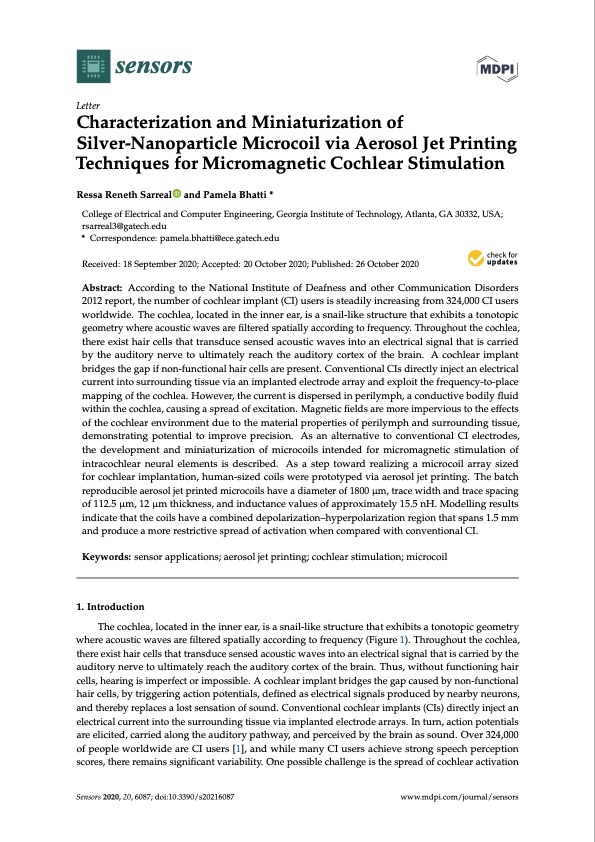
PDF Publication Title:
Text from PDF Page: 001
sensors Letter Characterization and Miniaturization of Silver-Nanoparticle Microcoil via Aerosol Jet Printing Techniques for Micromagnetic Cochlear Stimulation Ressa Reneth Sarreal and Pamela Bhatti * College of Electrical and Computer Engineering, Georgia Institute of Technology, Atlanta, GA 30332, USA; rsarreal3@gatech.edu * Correspondence: pamela.bhatti@ece.gatech.edu Received: 18 September 2020; Accepted: 20 October 2020; Published: 26 October 2020 Abstract: According to the National Institute of Deafness and other Communication Disorders 2012 report, the number of cochlear implant (CI) users is steadily increasing from 324,000 CI users worldwide. The cochlea, located in the inner ear, is a snail-like structure that exhibits a tonotopic geometry where acoustic waves are filtered spatially according to frequency. Throughout the cochlea, there exist hair cells that transduce sensed acoustic waves into an electrical signal that is carried by the auditory nerve to ultimately reach the auditory cortex of the brain. A cochlear implant bridges the gap if non-functional hair cells are present. Conventional CIs directly inject an electrical current into surrounding tissue via an implanted electrode array and exploit the frequency-to-place mapping of the cochlea. However, the current is dispersed in perilymph, a conductive bodily fluid within the cochlea, causing a spread of excitation. Magnetic fields are more impervious to the effects of the cochlear environment due to the material properties of perilymph and surrounding tissue, demonstrating potential to improve precision. As an alternative to conventional CI electrodes, the development and miniaturization of microcoils intended for micromagnetic stimulation of intracochlear neural elements is described. As a step toward realizing a microcoil array sized for cochlear implantation, human-sized coils were prototyped via aerosol jet printing. The batch reproducible aerosol jet printed microcoils have a diameter of 1800 μm, trace width and trace spacing of 112.5 μm, 12 μm thickness, and inductance values of approximately 15.5 nH. Modelling results indicate that the coils have a combined depolarization–hyperpolarization region that spans 1.5 mm and produce a more restrictive spread of activation when compared with conventional CI. Keywords: sensor applications; aerosol jet printing; cochlear stimulation; microcoil 1. Introduction The cochlea, located in the inner ear, is a snail-like structure that exhibits a tonotopic geometry where acoustic waves are filtered spatially according to frequency (Figure 1). Throughout the cochlea, there exist hair cells that transduce sensed acoustic waves into an electrical signal that is carried by the auditory nerve to ultimately reach the auditory cortex of the brain. Thus, without functioning hair cells, hearing is imperfect or impossible. A cochlear implant bridges the gap caused by non-functional hair cells, by triggering action potentials, defined as electrical signals produced by nearby neurons, and thereby replaces a lost sensation of sound. Conventional cochlear implants (CIs) directly inject an electrical current into the surrounding tissue via implanted electrode arrays. In turn, action potentials are elicited, carried along the auditory pathway, and perceived by the brain as sound. Over 324,000 of people worldwide are CI users [1], and while many CI users achieve strong speech perception scores, there remains significant variability. One possible challenge is the spread of cochlear activation Sensors 2020, 20, 6087; doi:10.3390/s20216087 www.mdpi.com/journal/sensorsPDF Image | Silver-Nanoparticle Microcoil via Aerosol Jet Printing

PDF Search Title:
Silver-Nanoparticle Microcoil via Aerosol Jet PrintingOriginal File Name Searched:
sensors-20-06087-v2.pdfDIY PDF Search: Google It | Yahoo | Bing
Turbine and System Plans CAD CAM: Special for this month, any plans are $10,000 for complete Cad/Cam blueprints. License is for one build. Try before you buy a production license. More Info
Waste Heat Power Technology: Organic Rankine Cycle uses waste heat to make electricity, shaft horsepower and cooling. More Info
All Turbine and System Products: Infinity Turbine ORD systems, turbine generator sets, build plans and more to use your waste heat from 30C to 100C. More Info
CO2 Phase Change Demonstrator: CO2 goes supercritical at 30 C. This is a experimental platform which you can use to demonstrate phase change with low heat. Includes integration area for small CO2 turbine, static generator, and more. This can also be used for a GTL Gas to Liquids experimental platform. More Info
Introducing the Infinity Turbine Products Infinity Turbine develops and builds systems for making power from waste heat. It also is working on innovative strategies for storing, making, and deploying energy. More Info
Need Strategy? Use our Consulting and analyst services Infinity Turbine LLC is pleased to announce its consulting and analyst services. We have worked in the renewable energy industry as a researcher, developing sales and markets, along with may inventions and innovations. More Info
Made in USA with Global Energy Millennial Web Engine These pages were made with the Global Energy Web PDF Engine using Filemaker (Claris) software.
Infinity Turbine Developing Spinning Disc Reactor SDR or Spinning Disc Reactors reduce processing time for liquid production of Silver Nanoparticles.
| CONTACT TEL: 608-238-6001 Email: greg@infinityturbine.com | RSS | AMP |